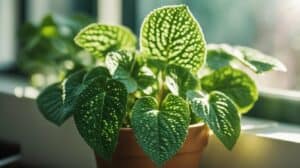The Sago Palm, scientifically known as Cycas revoluta, is a popular ornamental plant that has been around for centuries.
This timeless plant is native to Japan and is a favorite among gardeners and homeowners alike due to its unique, fern-like foliage and low maintenance requirements.
It’s no wonder that the Sago Palm is a common sight in gardens, patios, and even indoor spaces.

Caring for the Sago Palm involves a few simple steps.
The plant is hardy and can tolerate a range of conditions, making it an ideal choice for those who are new to gardening or those who don’t have a lot of time to devote to plant care.
In this article, we will explore the basics of Cycas revoluta care and maintenance, including watering, fertilizing, and pruning.
Whether you’re a seasoned gardener or a beginner, you’ll find useful tips and advice to help you keep your Sago Palm healthy and thriving.
Understanding Cycas Revoluta
Species Overview
Cycas Revoluta, commonly known as Sago Palm, is a slow-growing cycad native to southern Japan.
It is a popular ornamental plant in gardens and indoor spaces due to its unique appearance and low maintenance requirements.
The plant has a stout trunk that can grow up to 10 feet tall, topped with a crown of glossy, feathery leaves that can reach up to 4 feet long.
Sago Palm is a dioecious plant, which means that male and female reproductive organs are found on separate plants.
The female plants produce large cones that contain seeds, while the male plants produce smaller cones that release pollen.
Historical Significance
Sago Palm has a long history of use in Japanese culture. The plant was considered sacred and was often planted in temple gardens.
The seeds were used as a food source during times of famine, as they contain starch that can be processed into a flour-like substance.
The leaves were also used to make traditional Japanese clothing and household items.
In addition to its cultural significance, Sago Palm has also been used for medicinal purposes.
The plant contains compounds that have been shown to have anti-inflammatory and antioxidant properties, and it has been used to treat a variety of ailments including arthritis and liver disease.
Overall, Cycas Revoluta is a fascinating and versatile plant with a rich history and many uses.
By understanding its unique characteristics and cultural significance, gardeners and plant enthusiasts can better appreciate and care for this timeless species.
Essential Care Guidelines

Lighting Requirements
The Sago Palm thrives in bright, indirect light.
Direct sunlight can scorch its leaves, so it’s best to place it near a window with a sheer curtain or in a shaded outdoor area.
If the plant is not receiving enough light, its leaves may turn yellow and brown.
Watering Practices
It’s important to keep the soil of the Sago Palm moist but not waterlogged. Water the plant when the top inch of soil feels dry to the touch.
During the winter months, reduce watering to once every two weeks. Overwatering can lead to root rot and ultimately kill the plant.
Soil and Fertilization
The Sago Palm prefers well-draining soil that is rich in organic matter. A mixture of peat moss, sand, and perlite works well.
Fertilize the plant every two weeks during the growing season with a balanced fertilizer. Avoid fertilizing during the winter months.
Temperature and Humidity
The Sago Palm thrives in temperatures between 65-80°F (18-27°C). Avoid exposing the plant to temperatures below 50°F (10°C) or above 100°F (38°C).
The plant prefers moderate to high humidity levels, so it’s a good idea to mist the leaves regularly.
Propagation and Planting

Seed Propagation
Sago palms can be propagated by seeds. However, it takes a long time for the seeds to germinate, and the resulting plants may not resemble the parent plant.
To propagate using seeds, follow these steps:
- Soak the seeds in water for 24 hours before planting.
- Plant the seeds in a well-draining potting mix, covering them with a thin layer of soil.
- Keep the soil moist and warm, ideally around 80°F (27°C).
- Germination can take anywhere from several weeks to several months.
Offset Division
The most common method of propagating sago palms is by offset division.
This involves removing the offsets, or pups, that grow at the base of the parent plant and planting them separately.
To propagate using offset division, follow these steps:
- Wait until the offsets are at least one-third the size of the parent plant before removing them.
- Gently dig around the base of the parent plant to expose the offsets.
- Use a sharp, sterile knife to cut the offsets away from the parent plant.
- Plant the offsets in a well-draining potting mix, making sure they are planted at the same depth as they were growing previously.
- Water the offsets thoroughly and keep the soil moist until they are established.
Propagation and planting are essential steps in the care and maintenance of sago palms.
By following these guidelines, you can successfully propagate your sago palm and enjoy its timeless beauty for years to come.
Common Issues and Management

Pest Problems
The Sago Palm is relatively pest-free, but it can still fall prey to some common pests.
Scale insects, mealybugs, and spider mites are the most common pests to affect the Sago Palm.
Scale insects and mealybugs can be controlled by wiping the leaves with a damp cloth.
Spider mites can be controlled by spraying the leaves with water or insecticidal soap. In severe cases, chemical insecticides may be necessary.
Disease Control
The Sago Palm is susceptible to root rot, which is caused by overwatering or poor drainage.
To prevent root rot, ensure that the soil is well-draining and allow the soil to dry out between waterings.
If root rot is suspected, remove the affected roots and repot the plant in fresh, well-draining soil.
Maintenance Tips
Regular maintenance is essential for the health of the Sago Palm. Here are some tips to keep your plant healthy:
- Water the plant deeply once a week during the growing season and reduce watering during the winter months.
- Fertilize the plant with a balanced fertilizer every two to three months during the growing season.
- Prune dead or yellowing fronds to maintain the plant’s appearance and prevent the spread of disease.
- Keep the plant in a bright, indirect light and protect it from direct sunlight, which can scorch the leaves.
By following these tips and monitoring the plant for pests and diseases, the Sago Palm can thrive for years to come.
Frequently Asked Questions

How should I fertilize my sago palm for optimal growth?
Sago palms require regular fertilization to maintain their health and promote optimal growth.
Use a balanced, slow-release fertilizer with an NPK ratio of 8-8-8 or 10-10-10.
Apply the fertilizer every three months during the growing season (spring and summer) and reduce the frequency to once every six months during the dormant season (fall and winter).
Be careful not to over-fertilize, as this can cause damage to the plant.
What are the common issues affecting sago palms and how can I prevent them?
Sago palms are susceptible to various pests and diseases, including scale insects, mealybugs, and root rot.
To prevent these issues, ensure that your sago palm is planted in well-draining soil and avoid over-watering.
Regularly inspect your plant for signs of infestation and treat with an appropriate insecticide or fungicide as necessary.
What are the best practices for growing a sago palm indoors?
Sago palms can be grown indoors as long as they receive adequate light and are planted in a well-draining potting mix.
Place your plant in a bright, sunny location and water sparingly, allowing the soil to dry out slightly between watering.
Fertilize every three months during the growing season with a balanced, slow-release fertilizer.
How often should I water my Cycas revoluta?
Sago palms prefer well-draining soil and should be watered sparingly, allowing the soil to dry out slightly between watering.
In general, water your plant once a week during the growing season (spring and summer) and reduce the frequency to once every two weeks during the dormant season (fall and winter).
When is the right time to repot a sago palm, and how is it done?
Sago palms should be repotted every two to three years, or when the plant has outgrown its current container.
To repot, gently remove the plant from its current container and loosen any tangled roots.
Place the plant in a new container with fresh, well-draining soil and water thoroughly.
Can sago palms tolerate cold weather, and how do I protect them from frost?
Sago palms are hardy to USDA zones 9-11 and can tolerate temperatures as low as 15°F (-9°C).
However, prolonged exposure to cold temperatures can damage the plant.
To protect your sago palm from frost, cover it with a frost blanket or move it to a sheltered location during cold snaps.














